Pandyan dynasty
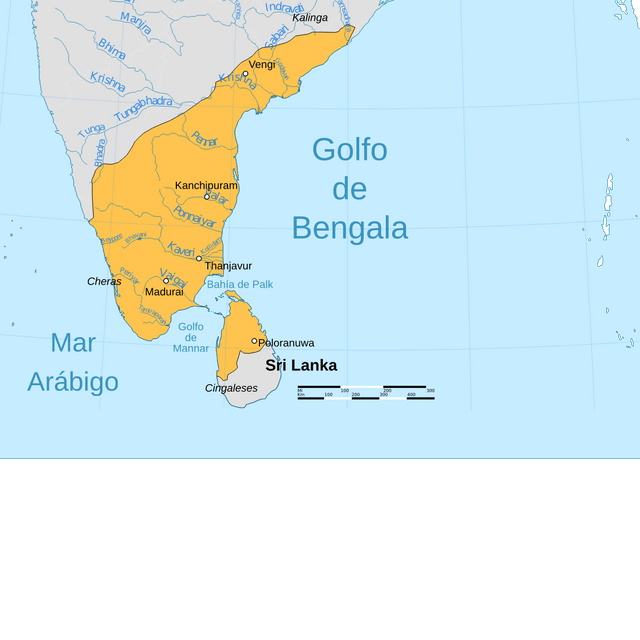
Pandyan dynasty
The Pandya dynasty, also known as the Pandyas of Madurai, was a dynasty of south India, one of the three ethnically Tamil lineages, the other two being the Chola and the Chera.[5] The rulers of the three dynasties were referred to as "the three crowned rulers (the muventar) of the Tamil country".[6] The Pandyas ruled extensive territories, at times including the large portions of present-day south India and Sri Lanka (through collateral branches subject to Madurai).[7]
The age and antiquity of the dynasty is difficult to establish.[7] The early Pandyas ruled their country (the Pandya nadu) from time immemorial, which inculded the inland city of Madurai and the southern port of Korkai.[8] The country of the Pandyas was described by a number of Graeco-Roman sources (as early as 4th century BCE[7]).[9][10][11] The Pandyas are celebrated in the earliest available Tamil poetry.[7] According to tradition, the legendary Sangams ("the Academies") were held in Madurai under the patronage of the Pandyas, and some of the Pandya rulers claim to be poets themselves. The early historic Pandyas faded into obscurity upon the rise of the Kalabhra dynasty in south India.
The Pandyas revived under Kadungon towards the end of the 6th century, helped to destablish the Kalabhras in south India.[12][13] They again went into decline with the rise of the Cholas of Tanjore in the 9th century and were in constant conflict with them. The Pandyas allied themselves with the Sinhalese and the Cheras in harassing the Chola empire until they found an opportunity for reviving their fortunes during the late 13th century. The later Pandyas (1216–1345) entered their "golden age" under Maravarman Sundara Pandya and Jatavarman Sundara Pandya (c. 1251), who expanded the empire into the Telugu country (as far north as Nellore[7]), and conquered Kalinga and Sri Lanka. They also had extensive trade links with the South East Asian maritime empires of Srivijaya and their successors. The Pandyas of Ucchangi (9th–13th century), in the Tungabhadra Valley are assumed to be related to the Pandyas of Madurai.[7]
During their history, the Pandyas were repeatedly in conflict with the Pallavas, Cholas, Hoysalas, Cheras (Keralas). An internal crisis in the Pandya empire coincided with the Khalji invasion of south India in 1310-11.[7] The ensuing political crisis saw more sultanate raids and plunder, the loss of south Kerala (1312), and north Sri Lanka (1323) and the establishment of the Madurai sultanate (mid 1330s).[14][15] In the mid-16th century, the Vijayanagara governors of Madurai declared independence and established the Madurai Nayak dynasty.[7]
The Pandya country was home to a number of renowned temples including Meenakshi Temple in Madurai. Ancient south Indian Hindu traditions flourished during the reign of the early Pandyas, but after the revival of the Pandya power by Kadungon, the Shaivite nayanars and the Vaishnavite alvars rose to prominence.[16] It is known that the Pandya rulers followed Jainism for a short period of time in history.[7]
Etymology and origin legends
The word pandya is thought to be derived from the ancient Tamil word "pandu" meaning "old".[17] The theory suggests that in early historic Tamil lexicon the word pandya means old country in contrast with Chola meaning new country, Chera meaning hill country and Pallava meaning branch in Sanskrit.[18] The etymology of pandya is still a matter of considerable speculation among scholars. Apart from the derivations mentioned, a number of other theories do appear in historical studies.[19]
According to the ancient Tamil legends, the three brothers Cheran, Cholan and Pandyan ruled in common at the southern city of Korkai. While Pandya remained at home, his two brothers Cheran and Cholan after a separation founded their own kingdoms in north and west.[20] Epic poem Silappatikaram mentions that the emblem of the Pandyas was that of a fish.[21] The Pandyas assumed several titles, one of them being Meenavan meaning "He of the Fish".[22]
Folklores attributes Alli Rani (literally "the queen Alli") as one of the early historic rulers of the Pandyas. She is attributed as a "amazonian queen" whose servants were men and administrative officials and army were women.[23] She is thought of ruling the whole western and northern coast of Sri Lanka from her capital Kudiramalai, where remains of what is thought of as her fort are found.[24] She is sometimes seen as an incarnation of the Pandya associated gods, Meenakshi and Kannagi.[25]
Sources of Pandya history
Archaeological sources
Kharavela, the Kalinga king who ruled during c. 1st century BCE, in his Hathigumpha inscription, claims to have destroyed a confederacy of Tamil states ("the tamira–desa–sanghata") which had lasted 132 years, and to have acquired a large quantity of pearls from the Pandyas.[27]
The earliest Pandya to be found in epigraph is Nedunjeliyan, figuring in the Tamil-Brahmi Mangulam inscription assigned to early historic period. The record documents a gift of rock-cut beds, to a Jain ascetic.[29] Silver punch-marked coins with the fish symbol of the Pandyas dating from around the same time have also been found.[30]
Early Tamil literature
The early historic Pandyas are celebrated in the earliest available Tamil poetry.[7] According to tradition, the legendary Sangams ("the Academies") were held in Madurai under the patronage of the Pandyas. Several Tamil literary works, such as Iraiyanar Agapporul, mention the legend of three separate Sangams and ascribe their patronage to the Pandyas.[31]
Pandya rulers – such as Nedunjeliyan, "the Victor of Talaiyalanganam" and Mudukudimi Peruvaludi "of Several Sacrifices" – find mention in a number of poems. Beside several short poems found in the Akananuru and the Purananuru collections, there are two major works – Mathuraikkanci and Netunalvatai – which give a glimpse into the society and commercial activities in the Pandya country during the early historic period.[32][33]
In the work Mathuraikkanci, the author Mankudi Maruthanar, refers to his patron, Nedunjeliyan, as the Lord of Korkai and the Warlord of the Southern Parathavar.[34] Maduraikkanci contains a full-length description of Madurai and the Pandya country under the rule of Nedunjeliyan.[35] The Netunalvatai (in the collection of Pattupattu) by Nakkirar contains a description of the Pandya ruler's palace.[36]
The Purananuru and Agananuru collections of contain poems sung in praise of various Pandya rulers and also poems that were claimed to be composed by the rulers themselves.[36]
Foreign sources
Pandyas are also mentioned by Greek author Megasthenes (4th century BCE) where he writes about south Indian kingdom being ruled by women.[37] He described the Pandya country in Indika as "occupying the portion of India which lies southward and extends to the sea". According to his account, the kingdom had 365 villages, each of which was expected to meet the needs of the royal household for one day in the year. He described the Pandya queen at the time, Pandaia as a daughter of Heracles.[38][39]
The Periplus of the Erythraean Sea (c. 60 – c. 100 CE) describes the riches of a "Pandian kingdom"
The country of the Pandyas was described as Pandya Mediterranea and Modura Regia Pandionis by Ptolemy.[9][10][41]
Strabo states that an Indian king called Pandion sent Augustus Caesar "presents and gifts of honour".[11][42] The 1st-century Greek historian Nicolaus of Damascus met, at Antioch, the ambassador sent by a king from India "named Pandion or, according to others, Porus" to Caesar Augustus around 13 CE (Strabo XV.4 and 73).[43][44]
The Roman emperor Julian received an embassy from a Pandya about 361 CE.[7]
Chinese historian Yu Huan in his 3rd-century CE text, the Weilüe, mentions the Panyue kingdom:
The Chinese traveler Xuanzang mentions a kingdom further south from Kanchipuram, a kingdom named Malakutta, identified with Madurai described by his Buddhist friends at Kanchipuram.[48]
In the later part of the 13th century (in 1288 and 1293 CE) Venetian traveller Marco Polo visited the Pandya kingdom and left a vivid description of the land and its people.[49][50]
Political history
Early Pandyas (c. 3rd century BCE – c. 3rd century CE)

Mangulam inscription
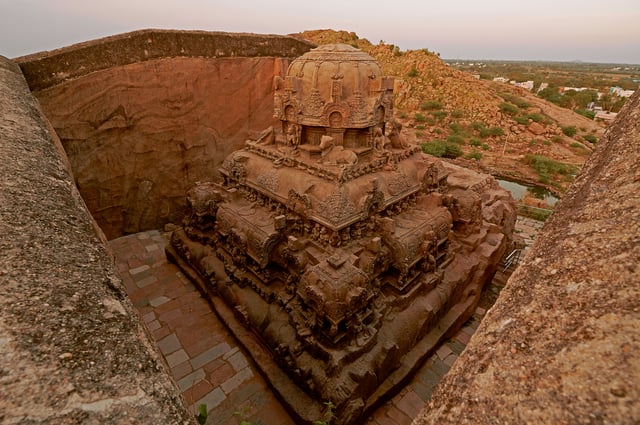
Vettuvan koil, Pandya kingdom, 8th century CE
Maurya emperor Asoka (3rd century BCE) seems to on friendly terms with the people of south India and Sri Lanka (the Cholas, the Pandyas, the Satiya Putras, the Kerala Putras and the Tamraparnis). There are no indications that the Asoka tried to conqure the extreme south India (the Tamilakam – the Abode of the Tamils).[52]
The three chiefly lines of the early historic south India – the Cheras, Pandyas and Cholas – were known as the mu-ventar ("the three ventar"). They traditionally based at their original headquarters in the interior Tamil Nadu (Karur, Madurai and Uraiyur respectively).[42] The powerful chiefdoms of the three ventar dominated the political and economic life of early historic south India.[53] The frequent conflits between the Chera, the Chola and the Pandya are well documented in ancient (the Sangam) Tamil poetry.[54] The Cheras, Cholas and Pandyas also controlled to the ports of Muziris (Muchiri), Korkai and Kaveri respectively (for the trade with the Graeco-Roman world).[42] The gradual shift from chiefdoms to kingdoms seems to have occurred in the following period.[53]
The famous inscription of king Kharavela at Hathigumpha (mid-first century BCE[42]) mentions the defeat of a confederacy of the "Tramira" countries which had been a threat to Kalinga. It also remembers the precious pearls brought to the capital as booty from the "Pandya" realm.[55] The Pandya chiefdom was famous for its pearl fisheries and silk industry.[42] Korkai and Alagankulam are believed to have been the exchange centres of the Pandyas. Korkai was linked to the famous pearl fisheris and Alagankulam was developed as a port.[56] A number of coins attributed to early historic Pandyas are found from the region.[54] Inscriptions, datable to c. 2nd century BCE, recording royal grants – both from royals and wealthy commoners – were also discovered from the Pandya country.[57]
The Pandya seems to be the most prominent of the three ventar rulers. There are even references to a Pandya queen from 3rd century BCE representing a confederacy of the Tamil countries.[42] Madurai, in south Tamil Nadu, was the most important cultural centre in south India as the core of the Tamil speakers.[57]
Megalithic relics such as menhirs, dolmens, urn burials, stone circles and rock-cut chambers/passages can be found in south India. Burial goods include iron objects, ivory ornaments, Black-and-Red Ware and even some Roman Imperial coins.[58] The so-called "velir" hill chieftains are assumed to be associated with these megalithic burials.[53]
The early Pandyas, along the with the Cheras and the Cholas, were eventually displaced by the Kalabhra dynasty.[59]
Koon Pandya Nedunjeliyan I ("Aariyap Padai Kadantha") Puda-pandya "Palyagasaalai" Mudukudumi Peruvaludi Nedunjeliyan II Nan Maran Nedunj Cheliyan III ("Talaiyaalanganathu Seruvendra") Maran Valudi Kadalan valuthi Musiri Mutriya Cheliyan Ukkirap Peruvaludi
Pandya revival (7th – 10th centuries CE)

Manikkavacakar, minister of Pandya king Varaguna II (c. 862 – 885 CE)
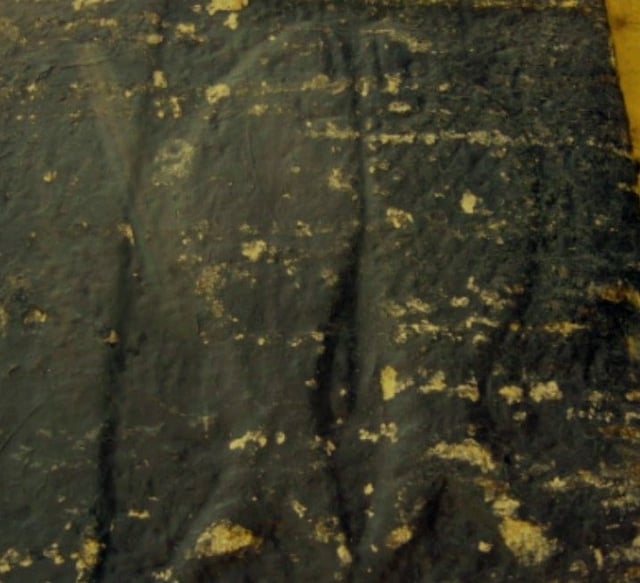
Jatavarman Veera Pandya II's double fish carp black granite bas-relief of the Koneswaram temple in Trincomalee, reminiscent of the dynasty's coinage symbols found on the island from the pre-modern era, installed after defeating the usurper Chandrabhanu of Tambralinga. Pandya affairs in Northern Sri Lanka grew stronger following the intervention of Srimara Srivallabha in 815 CE[62]
The Pandya kingdom was revived by king Kadungon (r. 590–620 CE[63]) towards the end of the 6th century CE.[7][64] In the Velvikudi inscription, a later copper-plate, Kadungon appears as the "destroyer" of the "anti-Brahmanical" Kalabhra kings.[63] With the decline of the Kalabhra dynasty, the Pandyas grew steadily in power and territory. With the Cholas in obscurity in Uraiyur, the Tamil country was divided between the Pallavas of Kanchi and the Pandyas of Madurai.
From 6th century to 9th century CE, the Chalukyas of Badami, the Pallavas of Kanchi, and Pandyas of Madurai dominated the politics of south India. The Badami Chalukyas were eventually replaced by the Rashtrakutas in the Deccan.[65] The Pandyas took on the growing Pallava ambitions in south India, and from time to time they also joined in alliances with the kingdoms of the Deccan Plateau (such as with the Gangas of Talakad in late 8th century CE).[57] In the middle of the 9th century, the Pandyas had managed to advance as far as Kumbakonam (north-east of Tanjore on the Kollidam river).[57]
Sendan (r. 654–70 CE), the third king of the Pandyas of Madurai, is known for expanding his kingdom to the Chera country (western Tamil Nadu and central Kerala).[63] Arikesari Maravarman (r. 670–700 CE), the fourth Pandya ruler, is known for his battles against the Pallavas of Kanchi.[63] Pallava king Narasimhavarman I (r. 630–68 CE), the famous conqurer of Badami, claimed to have defeated the Pandyas.[63] Chalukya king Paramesvaravarman I "Vikramaditya" (r. 670–700 CE) is known to have fought battles with the Pallavas, the Gangas, and probably with the Pandyas too, on the Kaveri basin.[63]
Kirtivarman II (r. 744/5–55 CE), the last Chalukya king, managed to lose to his southern countries as a result of his battles with the Pandyas.[63] Pandya kings Maravarman Rajasimha (r. 730–65 CE) and Nedunjadaiyan/Varagunavarman I (r. 765–815 CE) threatened Pallava king Nandivarman II Pallavamalla (r. 731–96 CE) who had managed to defeat the Gangas in around 760 CE.[63] Varagunavarman I invaded the Pallava country, conquered the Kongu country (western Tamil Nadu) and Venadu (south Kerala).[63] King Srimara Srivallabha (r. 815–62 CE) sailed to Sri Lanka, subjugated king Sena I, and sacked his capital Anuradhapura.[63] However, Srimara Srivallabha was soon overpowerd by Pallava king Nripatunga (r. 859–99 CE). Sena II, the king of Sri Lanka, sacked Madurai and chose Varagunavarman II as the new king soon after.[63] It is proposed that the start of the Kollam Era, the Kerala calendar, in 825 CE marked the liberation of Venadu from Pandya control.[66]
During the rule of Dantivarman (r. 796–847 CE), the Pallava territory was reduced by the encroachment from the Pandyas from the south (and Rashtrakutas and the Telugu-Chodas from north).[63] Pallava king Nandivarman III (r. 846–69 CE) was able to defeat the Pandyas and Telugu-Chodas (and even the Rashtrakutas) with the help of the Gangas and the emerging Cholas.[63]
Kadungon (r. c. 590–620 CE[63]) Maravarman Avani Sulamani (r. c. 620-645 CE) Jayantavarman alias Seliyan Sendan (r. c. 654–670 CE[63]) Arikesari Maravarman (r. c. 670–700 CE[63]) Kochadaiyan Ranadhiran (r. c. 700–730 CE) Maravarman Rajasimha I (r. c. 730–765 CE[63]) Nedunjadaiyan (Varagunavarman I[63]) (r. c. 765–815 CE[63]) Maravarman Rajasimha II (r. c. 815–817 CE) Varaguna I (r. c. 817–835 CE) Srimara Srivallabha (r. c. 815–862 CE[63]) Varaguna II (r. c. 862–885 CE) Parantaka Viranarayanan (r. c. 880–905 CE) Maravarman Rajasimha III (r. c. 905–920 CE)
Under Chola influence (10th – 13th centuries)
While the Pandyas and the Rashtrakutas were busy engaging the Pallavas, with the Gangas and the Simhalas also in the mix, the Cholas emerged from the Kaveri delta and took on the chieftains of Thanjavur.[70]
After the Chola king Vijayalaya conquered Thanjavur by defeating the Mutta Raiya chieftains (c. 850 CE), the Pandyas went into a period of decline. They were constantly harassing their Chola overlords by occupying their territories. Parantaka I (10th century) invaded the Pandya territories and defeated Rajasimha III. However, the Pandyas did not wholly submit to the Cholas despite loss of power, territory and prestige. They tried to forge various alliances with the Cheras of Kongu and the kings of Sri Lanka and tried to engage the Cholas to free themselves from the supremacy.[71][72]
The Chola domination of south India began in earnest during the reign of Parantaka II (10th century, r. 907–953 CE). Chola armies led by Aditya Karikala, son of Parantaka II defeated Vira Pandya in battle. The Pandyas were assisted by the Sinhalese forces of Mahinda IV. Pandyas were driven out of their territories and had to seek refuge on the island of Sri Lanka. This was the start of the long exile of the Pandyas.[73][74]
Chola emperor Rajaraja I (r. 985–1014 CE) is known to have attacked the Pandyas.[57] He fought against an alliance of the Pandya, Chera and Sri Lankan kings, and defeated the Cheras and "deprived" the Pandyas of their ancient capital Madurai.[75] Emperor Rajendra I continued to occupy the Pandya kingdom, and even appointed a series of Chola viceroys with the title "Chola Pandya" to rule from Madurai (over Pandya and Western Chera/Kerala countries).[75] The very of beginning of Chola emperor Kulottunga's rule (r. from 1070 CE) was marked the loss of Sri Lanka and the rebellion in the Pandya country.[75]
Rajadhiraja III aided Kulesekhara Pandya III by defeating the Sinhalese army and crowning him as king of Madurai.[73]
The second half of the 12th century witnessed a major internal crisis in the Pandya country (with neighbouring kingdoms of Sri Lanka, under Parakramabahu, Venadu Chera/Kerala, under the Kulasekharas, and the Cholas, under Rajadhiraja and Kulottunga III, joining in). Jatavarman Kulasekhara ascended the Pandya throne in 1190 CE.[73]
The following list gives the names of the Pandya kings who were active during the 10th century and the first half of 11th century.
Sundara Pandya I Vira Pandya I Vira Pandya II Amarabhujanga Tivrakopa Jatavarman Sundara Chola Pandya Maravarman Vikrama Chola Pandya Maravarman Parakrama Chola Pandya Jatavarman Chola Pandya Srivallabha Manakulachala (1101–1124 CE) Maravarman Srivallabha (1132–1161 CE) Parakrama I (1161–1162 CE) Kulasekara III Vira Pandya III Jatavarman Srivallabha (1175–1180 CE) Jatavarman Kulasekara I (1190–1216 CE)[74]
Pandya empire (13th – 14th centuries)
The Pandya empire included extensive territories, at times including large portions of south India and Sri Lanka. The Pandya family controlled these vast regions through the collateral branches subject to Madurai.[7] The 13th century saw the rise of seven prime Pandya "Lord Emperors" (Ellarkku Nayanar – Lord of All), who ruled the kingdom alongside Pandya princes. Their power reached its zenith under Jatavarman Sundara Pandya in the middle of the 13th century. The foundation for the Pandya supremacy was laid by Maravarman Sundara Pandya early in the 13th century.[76][77]
Parakrama Pandya II (king of Polonnaruwa) (1212–1215 CE) Maravarman Sundara Pandya (1216–1238 CE) Sundaravarman Kulasekara II (1238–1240 CE) Maravarman Sundara Pandya II (1238–1251 CE) Jatavarman Sundara Pandya (1251–1268 CE) Maravarman Kulasekara Pandya I (1268–1310 CE) Sundara Pandya IV (1309–1327 CE) Vira Pandya IV (1309–1345 CE)
Pandya power extended from the Telugu countries on banks of the Godavari river to Sri Lanka, which was invaded by Jatavarman Sundara Pandya I in 1258 and on his behalf by his younger brother Jatavarman Vira Pandya II from 1262 to 1264.[80] They ruled the whole peninsula and reduced the power of the Cholas and the Hoysalas, also making the Chera country and Sri Lanka Pandya provinces.[81] Later Jatavarman Sundara Pandya appointed his brother to rule Kongu, Chola and Hoysala countries.[82]
The marital alliance of Chola royal Kulothunga III and one of his successors, Rajaraja III, with the Hoysalas did not yield any advantage in countering the Pandya resurgence, who got defeated by Maravarman Sundara Pandya I, who after the victory burnt down Uraiyur and Thanjavur.[83] The Cholas renewed their control with the help of the Hoysalas under Hoysala king Vira Someshwara.[84] The later successor of Maravarman Sundara Pandya I, Maravarman Sundara Pandya II got defeated by Rajendra III around 1250.[83]
Jatavarman Sundara Pandya I subdued Rajendra Chola III around 1258–1260 CE and is considered as an equal antagonist of the Hoysalas.[83] He first vanquished the Kadava Pallavas under Kopperunchinga II, who had challenged the Hoysala army stationed in and around Kanchipuram and killed a few of their commanders.[85]
Around 1260, Jatavarman I first dragged the Hoysalas into war by routing Vira Someshwara's son Ramanatha out of Tiruchirappalli. Vira Someshwara Hoysala, who had given the control of the empire to his sons tried to challenge Jatavarman. Between Samayapuram and Tiruchirappalli, the armies of Vira Someshwara were routed with Vira Someshwara losing his life in this battle to Jatavarman Sundara Pandya I in Kannanur.[79][86]
Jatavarman I next concentrated on completely wiping out the Chola empire. Rajendra III had been counting on Hoysala assistance in case he was challenged by the Pandyas, keeping in mind the earlier marital alliance of the Cholas with the Hoysalas. Initially, Jatavarman consolidated the Pandya hold on Tiruchirappalli and Thiruvarangam and marched towards Thanjavur and Kumbakonam.[87] The Hoysala king Narasimha III joined hands with the Pandyas, opposing alliance with the Cholas.[84] When challenged by Jatavarman Sundara Pandya, Rajendra III marched against the Pandyas between Thanjavurand Tiruchirappalli, hoping for assistance and participation in war from the Hoysalas. However, the already vanquished Hoysalas were in a defensive position. They did not want to go to war and risk yet another defeat by the resurgent Pandyas. Jatavarman Sundara Pandya who defeated the Kadava Pallavas, Hoysalas and also the Telugu Choda, forced Rajendra III to become his tributary vassal.[88]
Jatavarman Sundara Pandiyan invaded Sri Lanka in 1258 and took control over Jaffna Kingdom by defeating the Javaka king Chandrabhanu, making the Javaka king paying tribute to him.[89] Chandrabhanu and two Sinhalese princes revolted against the Pandyas in 1270, and got his final defeat in 1270 by the brother of Jatavarman Sundara Pandya I, Jatavarman Vira Pandya II.[90]
Around 1279 the combined force of Hoysala Ramanatha and Rajendra Chola III was defeated by Maravarman Kulasekara Pandya I, giving an ultimate end to the Chola dynasty.[91]
Decline of Pandya empire
After the death of Maravarman Kulashekhara I (1310), his sons Vira Pandya IV and Sundara Pandya IV fought a war of succession for control of the empire. It seems that Maravarman Kulasekhara wanted Vira Pandya to succeed him (who inturn was defeated by Sundara Pandya after a short period of time).[92] Unfortunatley, the Pandya civil war coincided with the Khalji raids in south India.[93] Taking advantage of the political situation, the neighbouring Hoysala king Ballala III invaded the Pandya territory. However, Ballala had to retreat to his capital, when Khalji general Malik Kafur invaded his kingdom at the same time.[94] After subjugating Ballala III, the Khalji forces marched to the Pandya territory in March 1311.[95] The Pandya brothers fled their headquarters, and the Khaljis pursued them unsuccessfully.[96][97] By late April 1311, the Khaljis gave up their plans to pursue the Pandya princes, and returned to Delhi with the plunder.[98][99] By 1312 the Pandya control over south Kerala was also lost.[7]
After departure of the Khaljis, Vira and Sundara Pandya resumed their conflict. Sundara Pandya was defeated, and sought help from the Khaljis. With their help, he regained control of the South Arcot region by 1314.[99] Subsequently, there were two more expeditions from the sultanate in 1314 led by Khusro Khan and in 1323 by Ulugh Khan (Muhammad bin Tughluq) under sultan Ghiyath al-Din Tughluq.[99]
While the previous sultanate raids were content with plunder, the Tughlaqs under Ulugh Khan annexed the former Pandya dominions to the sultanate as the province of Ma'bar. Most of south India came under the sultanate rule and was divided into five provinces – Devagiri, Tiling, Kampili, Dorasamudra and Ma'bar.[100] Jalal ud-Din Ahsan Khan was appointed governor of the newly created southern-most Ma'bar province.[101] [102] In 1333, Jalal ud-Din Ahsan Khan declared his independence and created Madurai sultanate.[101][102] The Pandyas shifted their capital to Tenkasi and continued to rule the Tirunelveli, Tuticorin, Ramanad, Sivagangai regions.
Bukka Raya I of Vijayanagara empire conquered the city of Madurai in 1371, imprisoned the sultan, released and restored Arcot's Hindu prince Sambuva Raya to the throne. Bukka Raya I appointed his son Veera Kumara Kampana as the viceroy of the Tamil region. Meanwhile, Madurai sultanate was replaced by the Nayak governors of Vijayanagara in 1378.[103] In 1529 the Nayak governors declared independence and established Madurai Nayak dynasty.[7]
Architecture
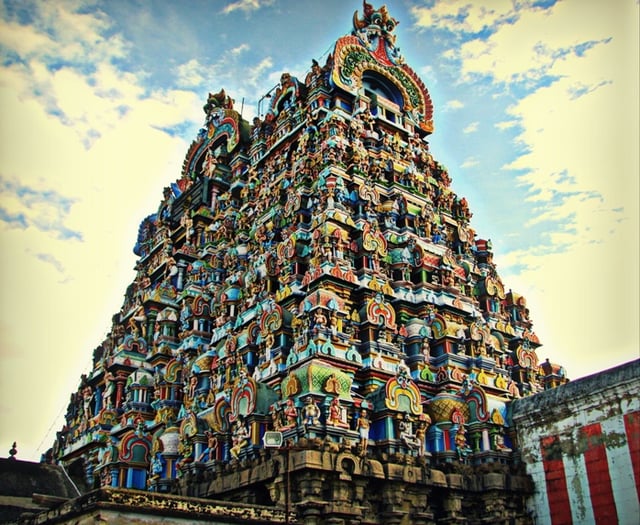
The Gopuram of Nellaiappar Temple
Rock cut and structural temples are significant part of the Pandya architecture. The vimana and mandapa are some of the features of the Pandya temples.[104]
Groups of small temples are seen at Tiruchirappalli district of Tamil Nadu. The Shiva temples have a Nandi bull sculpture in front of the maha mandapa.[105] In the later stages of Pandyas rule, finely sculptured idols, gopurams on the vimanas were developed. Gopurams are the rectangular entrance and portals of the temples.[106]
Meenakshi Amman Temple in Madurai and Nellaiappar Temple in Tirunelveli were built during the reign of the Pandyas.[107]
Coinage
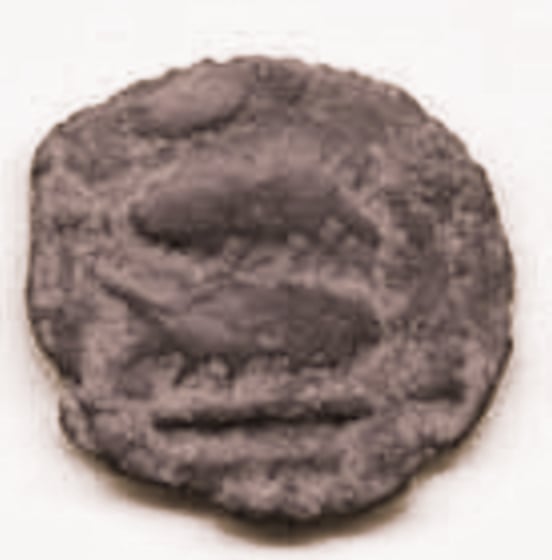
One of the early coins of the Pandyas showing their emblem of the two fishes.
The early coins of Tamilakam bore the symbols of the Three Crowned Kings, the tiger, the fish and the bow, representing the symbols of the Cholas, Pandyas and Cheras.[108] Coins of Pandyas bear the legend of different Pandya ruler in different times. The Pandyas had
Some of the coins had the names Sundara, Sundara Pandya or merely the letter 'Su' were etched. Some of the coins bore a boar with the legend of 'Vira-Pandya.[111] It had been said that those coins were issued by the Pandyas and the feudatories of the Cholas but could not be attributed to any particular king.
The coins of Pandyas were basically square. Those coins were etched with elephant on one side and the other side remained blank. The inscription on the silver and gold coins during the Pandyas, were in Tamil-Brahmi and the copper coins bore the Tamil legends.[112]
The coins of the Pandyas, which bore the fish symbols, were termed as 'Kodandaraman' and 'Kanchi' Valangum Perumal'.[113] Apart from these, 'Ellamthalaiyanam' was seen on coins which had the standing king on one side and the fish on the other. 'Samarakolahalam' and 'Bhuvanekaviram' were found on the coins having a Garuda, 'Konerirayan' on coins having a bull and 'Kaliyugaraman' on coins that depict a pair of feet.[114]
Economy and society
Economy
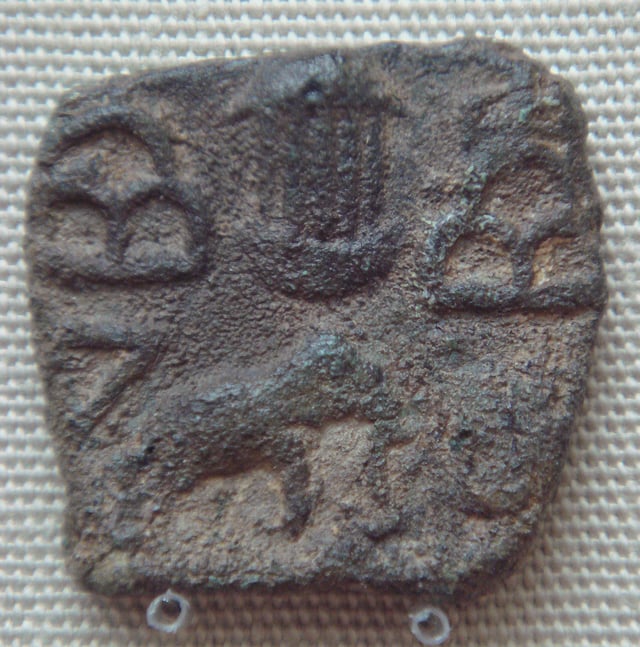
Pandya coin with temple between hills and elephant (Sri Lanka -1st century CE).
Graeco-Roman merchants frequented the ancient Tamil country, present day south India and Sri Lanka, securing contacts with the Tamil chiefdoms of the Pandya, Chola and Chera families.[115] The western sailors also establsihed a number of trading settlements on the harbours of the ancient Tamil region.[115]
The trade with South Asia by the Greco-Roman world flourished since the time of the Ptolemaic dynasty[116] a few decades before the start of the Common Era and remained long after the fall of the Western Roman Empire.[117][41] The contacts between south India and the Middle East continued even after the Byzantium's loss of the ports of Egypt and the Red Sea[118] in the 7th century CE.
The Pandya country, located at the extreme south-western tip of South Asia, served as an important meeting point throughout the history of the India. The location was economically and geopolitically significant as a key point connecting the shipping between Southeast Asia and the Middle East.
Pearl fishing
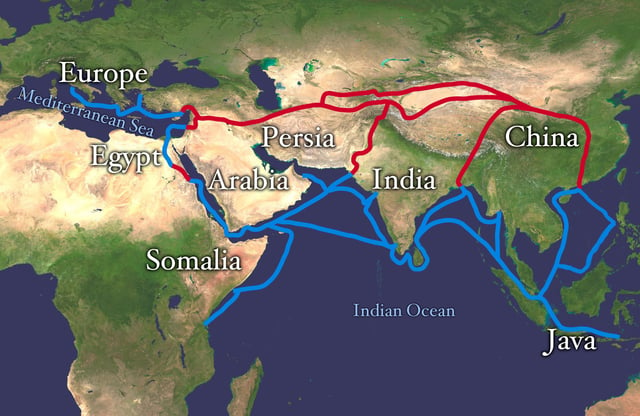
Silk Road map showing ancient trade routes.
The early historic Pandya country was famous for its supply of pearls. The ancient port of Korkai, in present-day Thoothukudi, was the center of pearl trade. Written records from Graeco-Roman and Egyptian voyagers give details about the pearl fisheries off the Gulf of Mannar. Megasthenes reported about the pearl fisheries, indicating that the Pandyas derived great wealth from the pearl trade.[119]
Religion
The Pandya country was home to a number of renowned temples including Meenakshi Temple in Madurai. Ancient south Indian Hindu traditions flourished during the reign of the early Pandyas, but after the revival of the Pandya power by Kadungon, the Shaivite nayanars and the Vaishnavite alvars of the Bhakti movement rose to prominence.[16]